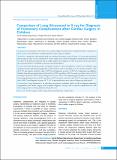Please use this identifier to cite or link to this item:
https://hdl.handle.net/20.500.14356/1194Full metadata record
| DC Field | Value | Language |
|---|---|---|
| dc.contributor.author | Bajracharya, Smriti Mahaju | - |
| dc.contributor.author | Shrestha, Pragati | - |
| dc.contributor.author | Sharma, Apurb | - |
| dc.date.accessioned | 2023-05-02T09:13:28Z | - |
| dc.date.available | 2023-05-02T09:13:28Z | - |
| dc.date.issued | 2020 | - |
| dc.identifier.citation | BajracharyaS. M., ShresthaP., & SharmaA. (2020). Comparison of Lung Ultrasound to X-ray for Diagnosis of Pulmonary Complications after Cardiac Surgery in Children. Journal of Nepal Health Research Council, 18(1), 47-51. https://doi.org/10.33314/jnhrc.v18i1.2236 | en_US |
| dc.identifier.issn | JNHRC Print ISSN: 1727-5482; Online ISSN: 1999-6217 | - |
| dc.identifier.uri | http://103.69.126.140:8080/handle/20.500.14356/1194 | - |
| dc.description | Original Article | en_US |
| dc.description.abstract | Abstract Background: The purpose of this study was to compare diagnostic performance of lung ultrasound in comparison to chest X-ray to detect pulmonary complication after cardiac surgery in children. Methods: A prospective observational study was conducted in tertiary center of Nepal. 141 consecutive paediatric patients aged less than 14 years scheduled for cardiac surgery were enrolled during the 6 months period. Ultrasound was done on the first post-operative day of cardiac surgery and compared to chest X-ray done on the same day to detect pleural effusion, consolidation, atelectasis and pneumothorax. Results: Sensitivity, specificity, positive and negative predictive values and diagnostic accuracy were calculated using standard formulas. lung ultrasonography had overall sensitivity of 60 %, specificity of 72.4%, positive predictive value of 31.9% and negative predictive value of 89.3% and diagnostic accuracy of 70.2% for diagnosing consolidation. Similarly, lung ultrasonography had overall sensitivity of 90%, specificity of 82.6%, positive predictive value of 46.1% and negative predictive value of 98% and diagnostic accuracy of 83.6 % for diagnosing pleural effusion. For atelectasis, ultrasonography had sensitivity of 50%, specificity of 76.9%, positive predictive value of 30.7% and negative predictive value of 88.2% and diagnostic accuracy of 72.3%. No pneumothoraxes were detected during our study period. Conclusions: Lung ultrasound is an alternative non-invasive technique which is able to diagnose pulmonary complications after cardiac surgery with acceptable diagnostic accuracy with no proven complications but with decreasing exposure to ionizing radiation and possibly cost. Keywords: Cardiac surgery; children; lung ultrasound; pulmonary complications | en_US |
| dc.language.iso | en | en_US |
| dc.publisher | Nepal Health Research Council | en_US |
| dc.relation.ispartofseries | Jan-Mar 2020;2236 | - |
| dc.subject | Cardiac surgery | en_US |
| dc.subject | Children | en_US |
| dc.subject | Lung ultrasound | en_US |
| dc.subject | Pulmonary complications | en_US |
| dc.title | Comparison of Lung Ultrasound to X-ray for Diagnosis of Pulmonary Complications after Cardiac Surgery in Children | en_US |
| dc.type | Journal Article | en_US |
| local.journal.category | Original Article | - |
| Appears in Collections: | Vol. 18 No. 1 (2020): Vol. 18 No. 1 Issue 46 Jan-Mar 2020 | |
Files in This Item:
| File | Description | Size | Format | |
|---|---|---|---|---|
| 2236-Manuscript-14305-1-10-20200420.pdf | Fulltext Article. | 230.86 kB | Adobe PDF |  View/Open |
Items in DSpace are protected by copyright, with all rights reserved, unless otherwise indicated.
